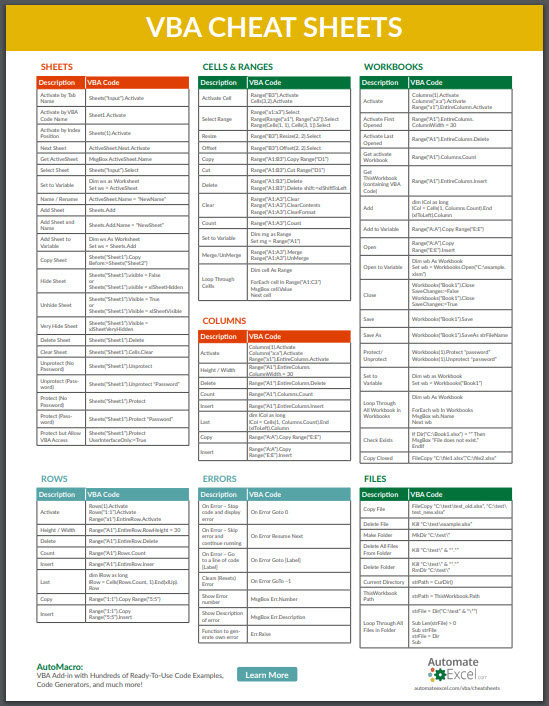Excel VBA: Easily Move to Next Sheet

Navigating through an Excel workbook with multiple sheets can often feel like a tedious task, especially when you need to switch between them frequently. If you're an Excel user looking to streamline your workflow, learning to use VBA (Visual Basic for Applications) to automate tasks such as moving to the next sheet can save you significant time and improve your efficiency. In this detailed guide, we'll explore how to use VBA in Excel to easily move between sheets with a single click or keystroke, enhancing both your productivity and user experience.
Why Use VBA for Sheet Navigation?

VBA is Microsoft's programming language for Office applications, allowing users to perform repetitive tasks, automate complex processes, and customize the user interface. Here's why you should consider VBA for sheet navigation:
- Automation: Automate the process of moving between sheets, which is especially useful in workbooks with dozens or even hundreds of sheets.
- Customization: Tailor Excel's functionality to suit your workflow. You can set custom shortcuts or buttons that do exactly what you need them to.
- Efficiency: Reduce the number of clicks or actions needed to perform simple navigation, increasing your speed and reducing errors.
Setting Up Your VBA Environment

Before diving into writing VBA code for moving sheets, make sure you have the Developer Tab enabled:
- Navigate to File > Options.
- Go to the Customize Ribbon section.
- Check the box next to Developer and click OK.
⚙️ Note: The Developer Tab gives you access to the VBA Editor, Macro controls, and other development tools.
Writing the VBA Code for Sheet Navigation

Let's start by creating a simple VBA subroutine to navigate to the next sheet:
Sub NextSheet()
If ActiveSheet.Index < ThisWorkbook.Sheets.Count Then
ActiveSheet.Next.Activate
Else
ThisWorkbook.Sheets(1).Activate
End If
End Sub
This subroutine checks if there are more sheets after the active sheet. If there are, it activates the next sheet. If the current sheet is the last one, it circles back to the first sheet.
Here's how to implement this code:
- Press Alt + F11 to open the VBA Editor.
- In the Project Explorer, find your workbook, right-click, and choose Insert > Module to add a new module.
- Paste the above code into the new module.
Assigning the Macro to a Shortcut or Button

To make the navigation easier, you can:
- Assign to a Shortcut: Go to the Developer Tab, click on Macros, find your NextSheet macro, and assign a shortcut like Ctrl + Shift + N.
- Add a Button: Go to the Developer Tab, choose Insert, then select the Button form control. Draw the button on your Excel sheet, and when prompted to assign a macro, choose your NextSheet macro.
Enhancing the Navigation Experience

Beyond just moving to the next sheet, you might want to:
- Set up similar macros for moving to the previous sheet or directly to a named sheet.
- Create a user form with buttons or a dropdown for more advanced navigation.
| Macro Name | Description |
|---|---|
| NextSheet | Moves to the next sheet or to the first if it's the last sheet. |
| PreviousSheet | Selects the sheet just before the active sheet or the last sheet if active sheet is the first. |
| GoToSheet | Allows you to select a sheet by name using a user form. |

Here's how you could write the PreviousSheet macro:
Sub PreviousSheet()
If ActiveSheet.Index > 1 Then
ActiveSheet.Previous.Activate
Else
ThisWorkbook.Sheets(ThisWorkbook.Sheets.Count).Activate
End If
End Sub
⚠️ Note: For these macros to work correctly, sheets should not be hidden or very hidden, as activating such sheets might require additional steps or permissions.
Key Takeaways and Best Practices

Here are some key takeaways for using VBA to improve sheet navigation in Excel:
- Keep your code simple and efficient. Avoid writing VBA that performs tasks Excel can do natively.
- Test your macros on a copy of your workbook to avoid data loss. VBA can have unintended consequences if not carefully tested.
- Document your code with comments to ensure others (or yourself in the future) can understand the purpose and functionality.
Integrating VBA into your Excel workflow can seem daunting at first, but with practice, it becomes second nature. Once you get used to navigating sheets with VBA, you'll find it hard to go back to manual methods. Moreover, mastering VBA opens up a realm of possibilities for automating other tasks within Excel, thereby transforming how you interact with data and spreadsheets.
How can I make my macro work when sheets are named with spaces or special characters?

+
You need to use the sheet’s code name (the one in the Project Explorer) or the Sheet Index instead of sheet names. For example, Sheets(SheetIndex) or use single quotes to surround the sheet name, like Sheets(“‘Sheet Name’”).
Can I move to a specific sheet by typing its name?

+
Yes, by creating a user form with a text input for the sheet name and then using a macro to navigate to that sheet. VBA provides tools like ‘InputBox’ or custom forms to handle this.
How do I handle sheets that are hidden or very hidden?

+
VBA can manage hidden sheets with commands like ActiveSheet.Visible = xlSheetHidden or xlSheetVisible to show or hide sheets. For very hidden sheets, you’ll need to use Workbook.Sheets(“SheetName”).Visible = True to make it visible first.



